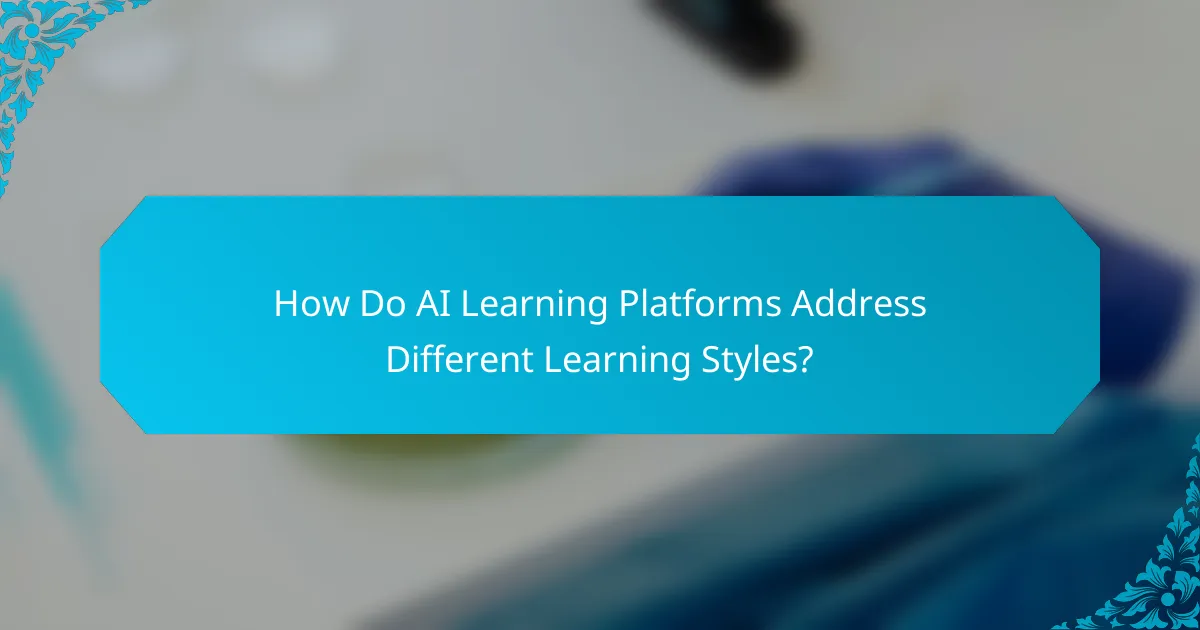AI learning platforms are increasingly essential in modern education, offering compatibility with various systems and devices for seamless access to content. By focusing on user experience, these platforms utilize educational apps that incorporate interactive elements and gamification, making learning more engaging and effective. When choosing an AI learning platform, it’s crucial to evaluate content quality, user interface, and accessibility to enhance the overall learning experience.

What Are the Best AI Learning Platforms for Compatibility?
The best AI learning platforms for compatibility are those that seamlessly integrate with various systems and devices, ensuring users can access content easily. Key considerations include integration with Learning Management Systems (LMS), support for multiple devices, and API access for customization.
Coursera: Integrates with various LMS
Coursera offers robust integration capabilities with popular Learning Management Systems like Moodle, Canvas, and Blackboard. This allows educational institutions to incorporate Coursera’s courses directly into their existing platforms, enhancing accessibility for students.
When using Coursera, institutions can track student progress and performance within their LMS, making it easier to manage learning outcomes. This compatibility is particularly beneficial for organizations looking to provide a blended learning experience.
edX: Supports multiple devices
edX is designed to be compatible with a wide range of devices, including desktops, tablets, and smartphones. This flexibility allows learners to access courses anytime and anywhere, making it ideal for busy professionals and students alike.
The platform’s responsive design ensures that users have a consistent experience across devices, which is crucial for maintaining engagement. Additionally, edX courses can be downloaded for offline access, further enhancing usability.
Udacity: Offers API access
Udacity provides API access that allows developers to integrate its learning resources into custom applications or existing platforms. This feature is particularly useful for organizations that want to tailor the learning experience to their specific needs.
By leveraging Udacity’s API, businesses can create personalized learning paths and track user engagement effectively. This level of customization can significantly enhance the educational experience, making it more relevant to individual learners or teams.

How Do Educational Apps Enhance User Experience?
Educational apps improve user experience by making learning engaging and accessible. They often incorporate interactive elements, personalized content, and gamification to keep users motivated and facilitate better retention of information.
Duolingo: Gamified learning approach
Duolingo employs a gamified learning approach that transforms language acquisition into a fun and interactive experience. Users earn points, unlock levels, and receive rewards for completing lessons, which encourages consistent practice.
This platform uses bite-sized lessons that cater to various learning styles, making it easy to fit language study into a busy schedule. The app’s competitive elements, such as leaderboards, foster a sense of community and motivation among learners.
Khan Academy: Personalized learning paths
Khan Academy offers personalized learning paths that adapt to each user’s pace and understanding. The platform assesses individual progress and recommends specific exercises to address knowledge gaps, ensuring a tailored educational experience.
Users can track their progress through dashboards that highlight strengths and areas for improvement. This personalized feedback helps learners stay focused and engaged, making it easier to achieve their educational goals.

What Factors Should You Consider When Choosing an AI Learning Platform?
When selecting an AI learning platform, consider factors such as content quality, user interface, and accessibility. These elements significantly impact the effectiveness and enjoyment of the learning experience.
Content quality and relevance
Content quality is crucial for an AI learning platform, as it determines how well the material meets educational standards and user needs. Look for platforms that provide up-to-date, well-researched content tailored to your learning objectives.
Relevance is equally important; ensure the platform covers topics that align with your interests or career goals. For example, if you’re interested in machine learning, choose a platform that offers specialized courses and resources in that area.
User interface and accessibility
A user-friendly interface enhances the learning experience by making navigation intuitive and engaging. Platforms should have clear menus, easy-to-read text, and responsive design that works well on various devices, including smartphones and tablets.
Accessibility is essential for all users, including those with disabilities. Check if the platform complies with accessibility standards, such as WCAG, and offers features like screen reader compatibility and adjustable text sizes. This ensures that everyone can benefit from the educational content provided.

How Do AI Learning Platforms Compare in Pricing?
AI learning platforms vary significantly in pricing structures, catering to different user needs and budgets. Understanding these pricing models can help learners choose the right platform for their educational goals.
Coursera: Subscription-based model
Coursera operates primarily on a subscription-based model, allowing users to access a wide range of courses for a monthly fee. Typically, this fee ranges from around $39 to $79 per month, depending on the specialization or course selected.
Users can benefit from unlimited access to courses during their subscription period, which is ideal for those looking to learn at their own pace. However, it’s essential to consider that if the subscription is not canceled, costs can accumulate quickly.
edX: Free courses with paid certificates
edX offers many free courses, allowing learners to access high-quality educational content without any upfront cost. However, if users wish to earn a verified certificate upon completion, they must pay a fee, usually between $50 and $300, depending on the course.
This model provides flexibility for learners who want to explore subjects without financial commitment initially. It’s advisable to review course details and certification costs before enrolling to avoid unexpected expenses.

What Are the User Experience Features of Top AI Learning Platforms?
Top AI learning platforms prioritize user experience through intuitive design, interactive elements, and community engagement. These features enhance learning efficiency and foster a supportive environment for users.
Interactive quizzes and assessments
Interactive quizzes and assessments are essential for reinforcing knowledge and tracking progress. Many platforms utilize adaptive testing, which adjusts the difficulty based on user performance, ensuring a tailored learning experience.
Consider platforms that offer a variety of question types, such as multiple-choice, fill-in-the-blank, and scenario-based questions. This diversity keeps users engaged and helps solidify their understanding of the material.
To maximize the benefits, regularly participate in quizzes and review feedback. This practice can help identify areas for improvement and guide further study efforts.
Community forums and support
Community forums and support systems are vital for enhancing the user experience on AI learning platforms. These spaces allow learners to ask questions, share insights, and connect with peers, creating a collaborative learning environment.
Look for platforms that offer active forums with knowledgeable moderators and a diverse user base. This can significantly enrich your learning experience by exposing you to different perspectives and resources.
Engage regularly in discussions and seek help when needed. However, be cautious of misinformation and always verify advice from credible sources within the community.

How Do AI Learning Platforms Address Different Learning Styles?
AI learning platforms cater to various learning styles by utilizing diverse instructional methods and technologies. These platforms incorporate visual, auditory, and kinesthetic elements to engage learners effectively and enhance their educational experience.
Visual aids and multimedia content
Visual aids and multimedia content are essential for learners who grasp information better through images and videos. AI learning platforms often include infographics, animations, and interactive simulations that make complex concepts more accessible and engaging.
For example, a platform might use video tutorials alongside written content to cater to visual learners. This combination helps reinforce understanding and retention, as users can see the practical application of theories in real-time.
Adaptive learning algorithms
Adaptive learning algorithms personalize the educational experience by adjusting content based on individual performance and preferences. These algorithms analyze user interactions to identify strengths and weaknesses, allowing the platform to offer tailored resources that suit each learner’s style.
For instance, if a student struggles with a particular topic, the platform may provide additional practice exercises or alternative explanations. This targeted approach helps learners progress at their own pace, ensuring they grasp foundational concepts before moving on to more advanced material.

What Are the Emerging Trends in AI Learning Platforms?
Emerging trends in AI learning platforms include the integration of advanced technologies like virtual reality (VR) and augmented reality (AR), along with a heightened emphasis on data privacy and security. These trends aim to enhance user engagement and protect sensitive information in educational environments.
Incorporation of VR and AR technologies
The incorporation of VR and AR technologies in AI learning platforms provides immersive experiences that can significantly enhance learning outcomes. For instance, students can explore complex subjects like anatomy or physics through interactive simulations, making abstract concepts more tangible.
Educational apps utilizing VR and AR can offer hands-on training in fields such as medicine or engineering, where practical experience is crucial. These technologies can also cater to different learning styles, allowing visual and kinesthetic learners to grasp information more effectively.
Increased focus on data privacy and security
As AI learning platforms collect vast amounts of user data, there is an increased focus on data privacy and security to protect users’ personal information. Compliance with regulations like GDPR in Europe and FERPA in the United States is essential for educational institutions to maintain trust and avoid legal repercussions.
Platforms are implementing robust security measures, such as encryption and secure access protocols, to safeguard sensitive data. Users should look for platforms that clearly outline their data protection policies and offer transparency regarding data usage and storage practices.
